Menu
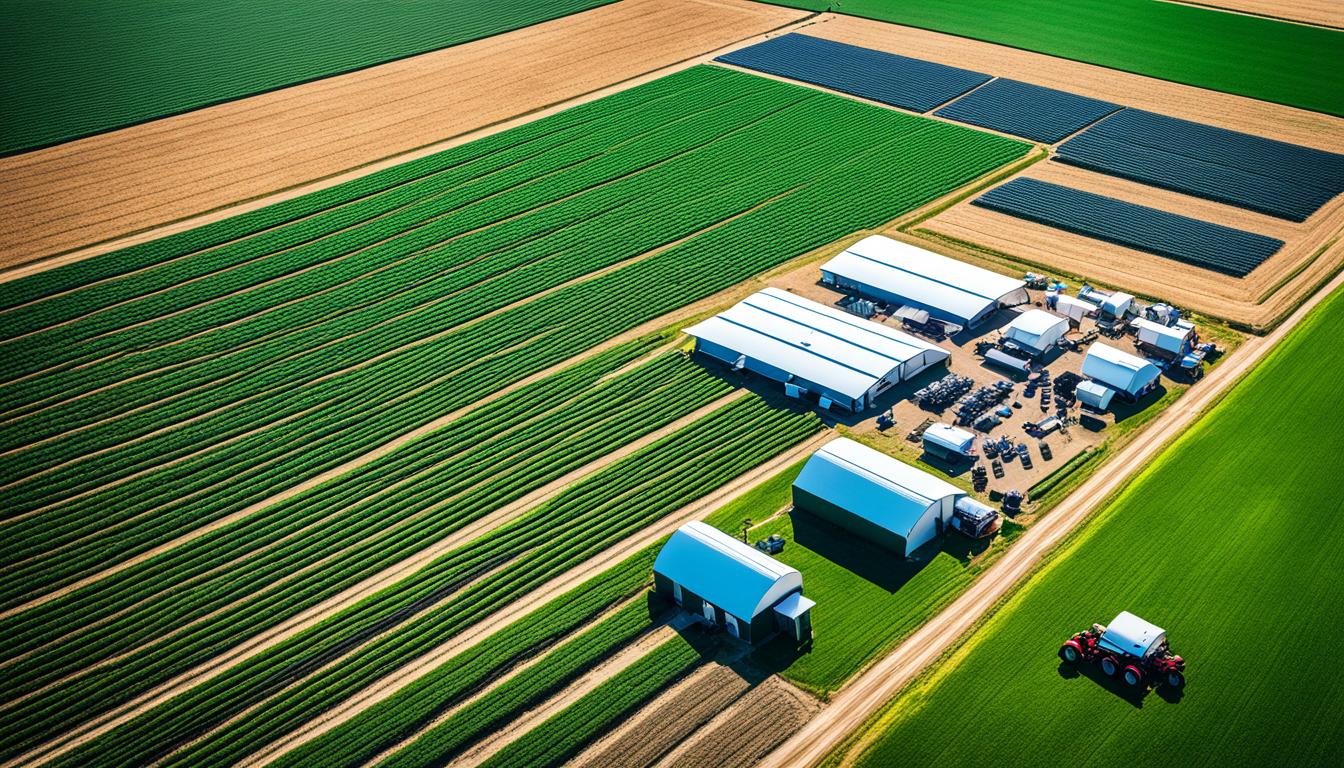
Precision agriculture is changing the game for farmers. It boosts crop growth and slashes costs while upping yields. Thanks to advanced tech like GPS and drones, farmers get detailed data on their crops. This data includes everything from their health to weather forecasts. It helps them make better decisions.
For today’s farmers, these high-tech tools are a must. They help use resources smarter to grow better crops. From big farms to small ones, the goal is the same. They aim to make food more secure worldwide and keep soils healthy.
Precision agriculture is a big step forward in farming. It uses high-tech tools to improve the quality and amount of crops. This new way of farming uses things like satellite pictures and maps to focus on different areas of a field. By doing this, farmers can make smart decisions quickly. These decisions are based on real-time information about their crops, the weather, and the environment.
At its heart, precision agriculture means using smart tools to run farms better. Farmers get a clear look at their land with tools such as satellite images and mapping. This approach helps farmers use their resources well, cutting down on waste. It also lets farmers adapt to different needs and changes by using technology like GPS, drones, and satellite data.
Precision agriculture uses several high-tech tools. Here are some:
These tools not only make farming more efficient but also more sustainable. Precision agriculture is reshaping the farming industry. It’s a mix of old and new, leading us towards a farming future that is both good for the planet and productive.
Precision agriculture is a key part of making farming more sustainable. It uses high-tech tools like GPS, drones, and satellites. These help farmers understand their land better. They can see how their crops are doing, what the weather is going to be like, and how the environment is changing. This helps them make smart choices to use their resources well.
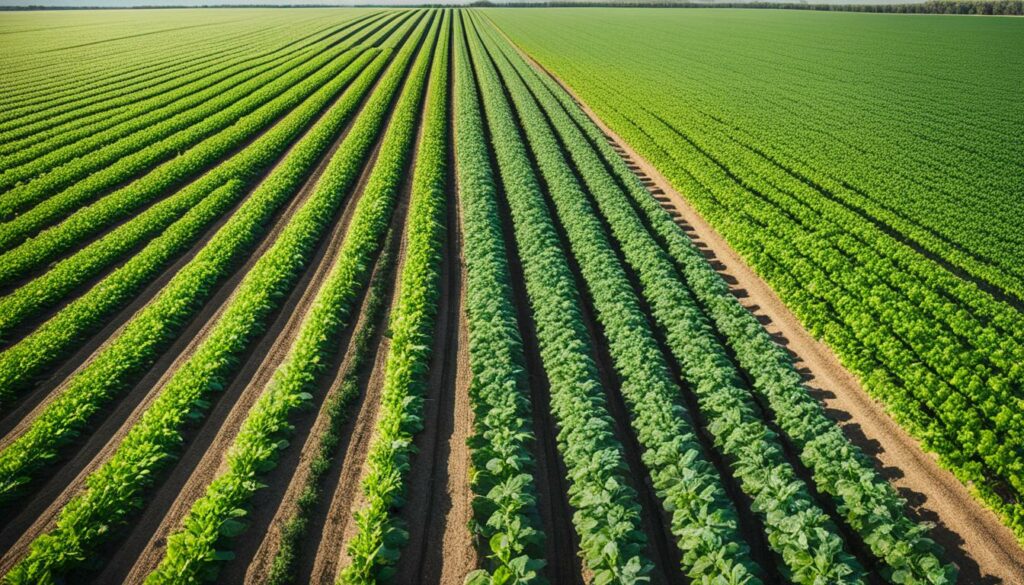
Precision agriculture helps the planet by using fewer chemicals and making fertilisers work better. It does this by applying the right amount of these substances where they’re needed in the field. This means healthier soil and better crops.
Though starting with precision farming tools might be expensive, the savings over time are big. It not only helps the environment but also means better crops and more of them.
Using precision agriculture can save farmers money and make their farms work better. They get real-time data that helps them plan more accurately. This makes their farms more profitable.
For our planet, precision agriculture is crucial. It keeps the soil healthy and avoids waste. This is important for making sure we have enough food. Technologies like GIS help in planning where and how to use these farming techniques.
| Technology | Benefits |
|---|---|
| GPS | Mapping irrigation systems, analysing soil health, and guiding machinery with precision |
| GIS | Farm zoning, nutrient management, and multiple farm management options |
| Drones | Remote crop monitoring, soil analysis, and enhanced pest management |
| Satellite Imaging | High-resolution crop health observation, stress detection, and nutrient deficiency identification |
| VRT | Customised input applications, resource efficiency, and environmental impact reduction |
Precision agriculture is key for better farming and a healthier earth. It uses tech to boost efficiency and save money. This means less waste, healthier soil, and bigger harvests.
Precision agriculture greatly boosts how much crops we grow. With GPS, drones, and satellites, farmers get exact, real-time details to make best choices for their crops. This has upped harvests by up to 4%, changing how we farm. It’s not just about more food. It helps feed the world and protect the environment.
This tech smartly uses resources where they’re needed. Variable Rate Technology (VRT) lets farmers put fertilisers, seeds, and chemicals only where they’re useful. This cuts waste and ups efficiency by 7%. It’s also lowered pesticide use by 9% and reduced fossil fuel use by 6%. These steps help keep the land healthy and lower the farm’s impact on our planet.
Precision agriculture helps farmers deal with changing climates. It lessens the impact of weather ups and downs. Tools like remote sensing and GIS help farmers plan better and act fast. For instance, satellite info helps spot crop problems early. This means farming can be less weather-dependent and more stable.
| Metrics | Outcomes with Precision Agriculture |
|---|---|
| Crop Production | 4% Increase |
| Fertiliser Placement Efficiency | 7% Increase |
| Pesticide Use | 9% Reduction |
| Fossil Fuel Use | 6% Reduction |
| Water Use | 4% Reduction |
| CO2 Emissions Avoided | 10.1 Million Metric Tons |
Precision agriculture is shaking up how we farm for the better. It’s all about getting the most from our crops, using resources well, and being ready for whatever the weather brings. This tech is becoming a must-have for farming that’s modern and eco-friendly.
The use of GPS in precision agriculture has changed how farms are managed. It gives accurate information for seed and fertiliser use, as well as for moving through fields. This makes farming more precise and efficient.
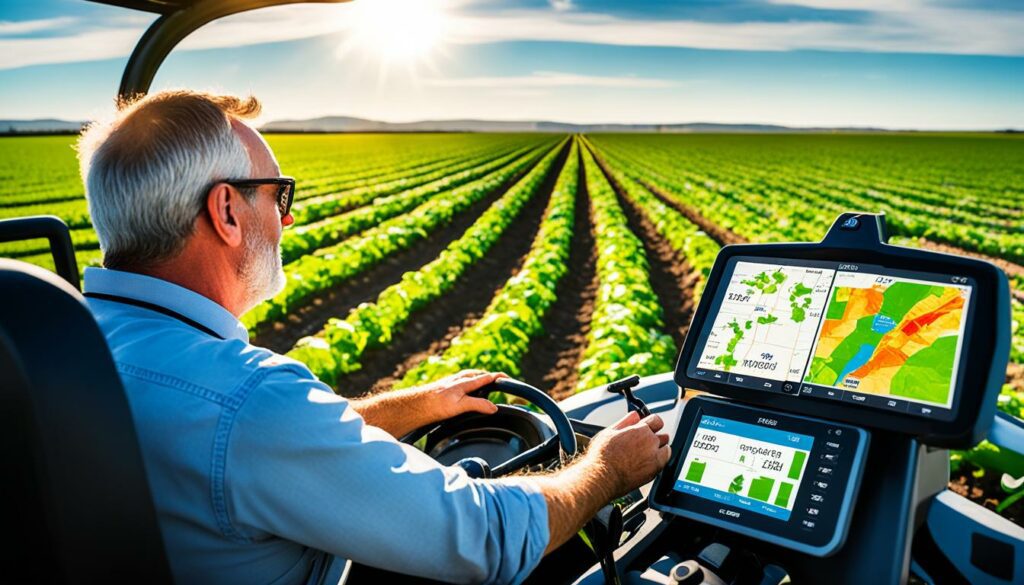
GPS in farming offers many benefits, including making detailed farm maps and guiding machines accurately. Farmers can map and control water systems better, saving water. It also helps in sampling soil, making data more accurate.
For advisors, it offers detailed maps of pests and weeds, leading to smarter decisions. This means better agriculture management overall.
GPS has many advantages in agriculture. It makes working in bad weather easier and boosts productivity. The U.S. government is improving GPS for agriculture.
This will help reduce chemicals in the environment. GPS is also affordable and user-friendly, benefiting many farms.
GPS’s precision allows for accurate maps and less chemical waste. It does not need human help to guide machines, improving how crops are sprayed.
As GPS gets better, it will keep helping farms be more efficient. It is key to modern farming.
In precision agriculture, GIS does a lot to help, working with other tech to make farm life better. It puts together data from space and time to make detailed maps for farming. This helps see the big picture on the land.
GIS makes it easier for farmers to look at loads of data and make smart choices. They can make maps that show which parts of fields are doing well and which need help. These maps help use things like water and fertilisers smartly.
They also help with flying drones and satellite checks. This makes checking on soil and crops very precise.
Looking at the type of soil is key to growing crops. Satellites, like Landsat 8, take many pictures to see how plants are doing. They can tell if plants need more food, are sick, or too dry.
Technology connects this info with the weather and soil wetness. This lets farmers keep an eye on the fields without even being there. They know which areas need more work and where things are going well.
| Technology | Usage | Benefits |
|---|---|---|
| GIS Mapping | Analyzing field data for decision-making | Precise resource allocation, increased yield |
| Satellite Sensors | Soil and crop health monitoring | Accurate data on crop health and soil moisture |
| EOSDA Crop Monitoring | Combining historical and current data | Comprehensive analysis of field activities |
In recent times, unmanned aerial vehicles (UAVs) have changed how farming works. They bring together old ways and new tech, which boosts crop study and makes farming more efficient. This change is mainly seen in advanced nations who use photogrammetry and remote sensing. These methods help crops grow better and lower the amount of work for farmers.
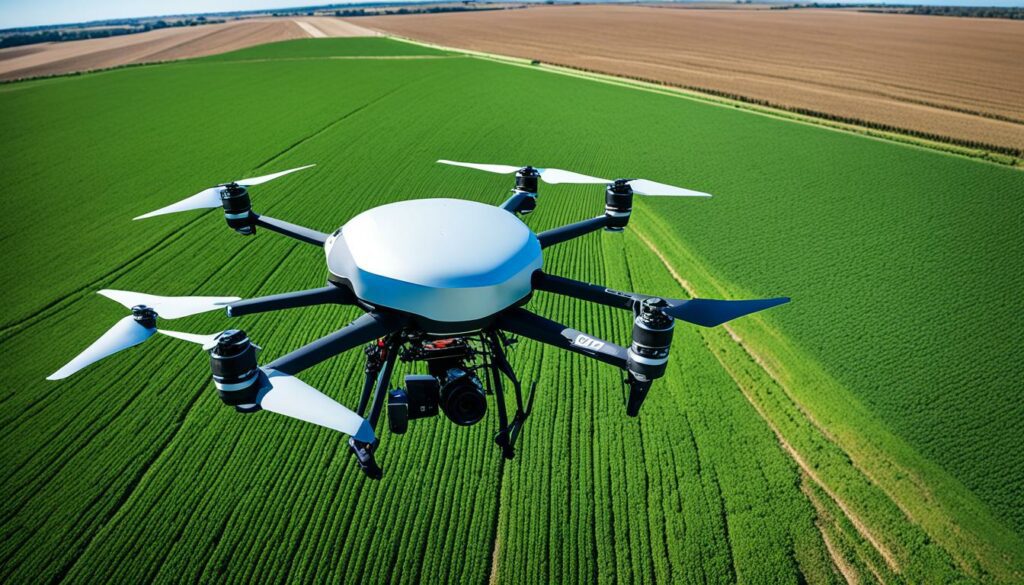
An important job for UAVs in farming is checking on crops from afar. They do this job well, which gets rid of the need for farmers to check fields by hand. These drones are built to fly low, have great cameras, and take detailed pictures. These pictures help farmers see problems early and handle them quickly.
Different types of drones are used for different farm needs. For example, drones that look like planes do well at mapping large areas because they fly efficiently and have sharp cameras. On the other hand, drones with many blades are extremely steady and easy to control, great for close-up looks at fields.
Using UAVs in farming brings lots of benefits. Drones do more than just check crops. They can also look closely at the soil to help with fighting diseases and pests. And with smart tech like IoT, drones link up to the internet, store big data, and offer new software tools. This helps farmers do their work better.
Drones come in different sizes, with the smallest ones, weighing under 5 kgs, being very handy and not expensive. These small drones can do many jobs on the farm, from making maps to checking crop health, or even spraying pesticides precisely.
Here’s a list of what each type of drone is good at:
| Type of UAV | Advantages |
|---|---|
| Fixed-Wing | Excellent aerodynamics, longer flight time, high-resolution mapping |
| Single Rotor | Helicopter component, ground-level control, various sensors |
| Hybrid VTOL | Efficient take-off, combined features, multiple controllers |
| Multi-Rotor | Stability and manoeuvrability, popular models include tricopters and quadcopters |
In the end, the benefits of using UAVs in farming are plenty. They reduce the hard tasks for farmers and make looking after crops and fighting diseases easier. UAVs are now a key tool for modern farming.
Satellite technology is changing how farmers work with their fields. It offers detailed images and real-time data. This is crucial as the need for food will grow a lot by 2050.
High-resolution imagery is key in modern farming. It picks up tiny changes in crops. This helps farmers know about water, crops, and soil conditions quickly and accurately.
This detail aids in spotting crop stress early. Farmers can then handle small problems before they get big.
Getting data in real time is a big plus of this technology. It checks soil conditions like organic matter and pH level instantly. Farmers can then decide when to water, manage crops, and prepare for disasters quickly.
Quick agricultural data improves harvests and protects the environment.
In today’s farming world, precision tools are changing everything. They are a mix of top-notch software and hardware. These tools bring together ground-based, aerial, and satellite tech. This setup makes farming smarter, saving money and boosting how much we can grow.
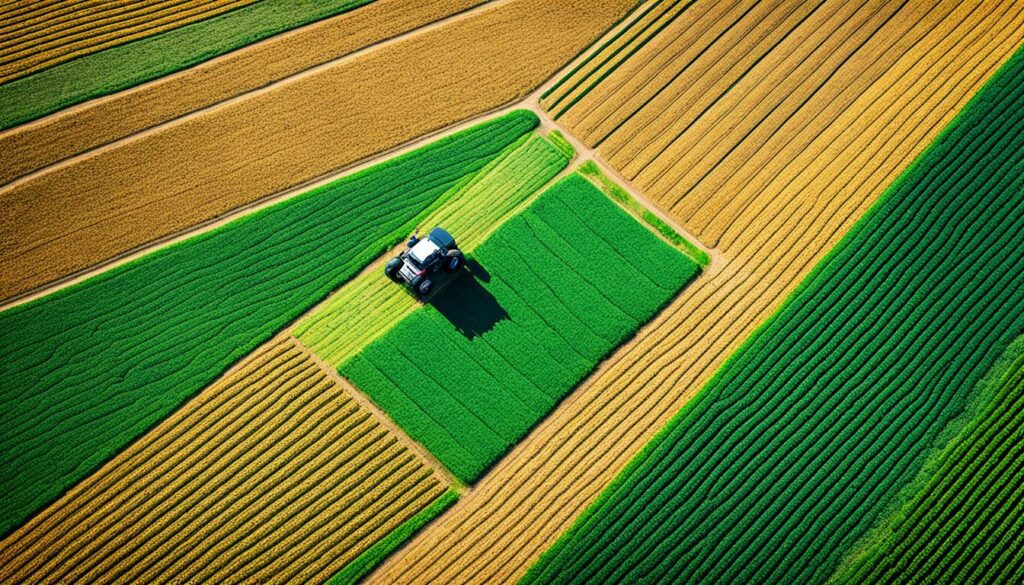
Bringing together software and hardware is key in precision farming. Software like EOSDA Crop Monitoring gathers data from many places. This lets farmers see how their crops, soil, and the weather are doing. They can tweak their irrigation from afar, making sure not a drop is wasted in dry areas.
Farm management platforms are crucial in precision farming gear. They use the Internet of Things (IoT) to link up sensors and devices. This makes gathering and looking over data easier. Wireless sensors give info on important things like how wet the soil is, its nutrients, and if there’s any pests. With this detailed info, farmers can use fertilisers and pesticides just where they’re needed.
Variable Rate Technology (VRT) changes the game in farming. It lets farmers tailor how they apply fertilisers, chemicals, and seeds. They do this to match the exact needs of their fields. This cuts waste and uses resources better.
VRT is great at making fertiliser use more precise. Farmers look closely at different parts of their fields and adjust as needed. So, plants get exactly what they require, leading to great health and growth. It also helps the environment by using fewer chemicals and keeping the soil in good shape.
Using VRT saves a lot of money. Farmers only apply inputs where they’re needed, cutting extra costs. Also, it uses 6% less fossil fuel and saves 4% water, helping the planet. Technologies like RTK offer very precise application, boosting savings even more.
| Benefit | Percentage Improvement |
|---|---|
| Production Increase | 4% |
| Fertiliser Use Reduction | 7% |
| Herbicide Application Decrease | 9% |
| Fossil Fuel Use Reduction | 6% |
| Water Usage Savings | 4% |
VRT boosts farm yields and saves money. It also makes farming better for the planet and for people. Adding technologies like GIS and remote sensors to VRT will improve it further. This helps us support a greener future for agriculture.
Yield monitoring and mapping are central to modern farming. They greatly help in making harvest plans better. These tools use technology to show how fields vary, which can lead to better crop results.
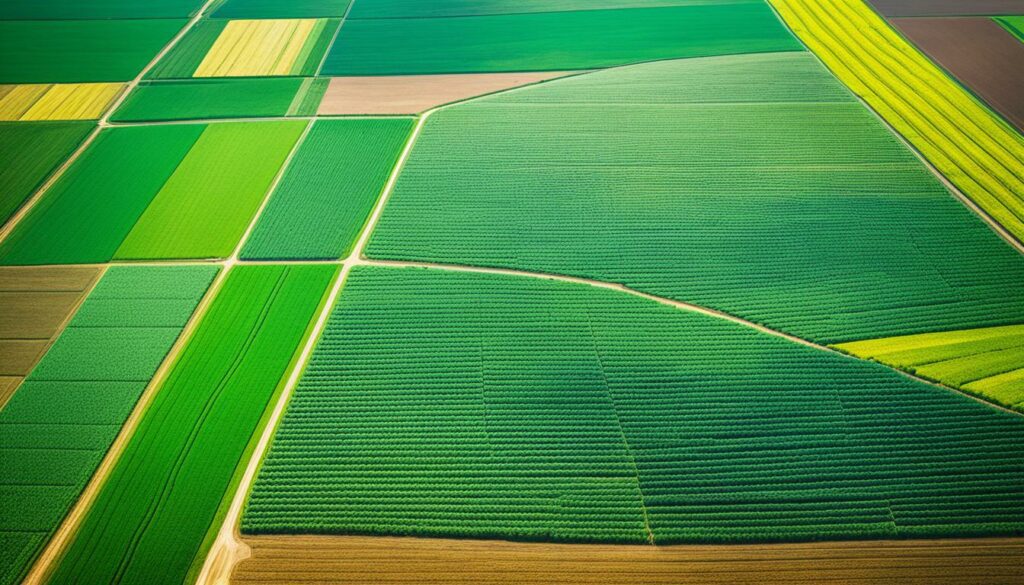
This technology is a big help in making smart farm decisions. It shows where fields differ, allowing farmers to adjust what they do. For example, they can look at data over time to understand what affects crop growth.
Since the 1990s, yield monitors have been collecting data on grain and moisture. This information is key for choosing when to add fertilisers or water. It also helps farmers look back at data from previous years to make better future choices.
Yield mapping uses advanced technology for detailed data gathering. It includes devices like grain sensors, GPS, and monitors. This lets farmers track crop amounts and quality as they work.
These devices allow real-time monitoring of crops and moisture. Data is marked with the field’s location for later studying. The process filters out bad data, making the remaining data more exact.
The result is detailed maps showing field differences, usually with several colours. These maps help farmers understand their fields better. They are very useful for improving farming methods and can even help in getting loans.
| Component | Role |
|---|---|
| Mass Flow Sensor | Measures the amount of grain harvested |
| Moisture Sensor | Monitors grain moisture content |
| GPS Receiver | Provides precise location data |
| Yield Monitor | Displays real-time data for decision-making |
When buying yield monitoring tools, it’s important to check they fit your farm’s equipment. Look for features that match your crops and consider the cost. Prices start from £2,000 for basic models, with fancier options available.
The world of precision agriculture is always growing. It uses the newest tech to make farming better and kinder to the planet. Technologies like in-ground sensors and automatic machines are changing how we farm for the better.
In-ground sensors are a big step in soil monitoring advancements. They give us instant info on soil moisture, temperature, and nutrients. This helps farmers decide the best times to water, when to put fertiliser, and more. It saves water, makes crops better, and helps the planet too.
These new ways to keep an eye on the soil fit the trend of using smart tech in farming. They let us learn things we couldn’t before. This helps us grow more crops with less work.
Adding automatic machines to farming is a big deal. They cut down on how much people need to do. Machines like weeders and harvesters work by themselves. This means farms can run well even if there’s not a lot of people to help.
There are also machines that plant seeds just right and spray plants when they need it. Using these tools makes farms more productive, reduces costs, and helps the environment. It’s all about farming smarter with the latest technology.
More and more, we will use these new farming tools. Combining soil monitoring and using automatic machines is the key. It makes farming about data, saving resources, and caring for the environment.
Although precision agriculture offers great benefits, its adoption faces several hurdles. It’s vital to know these challenges. This helps in finding solutions to support farmers in using advanced agricultural methods.
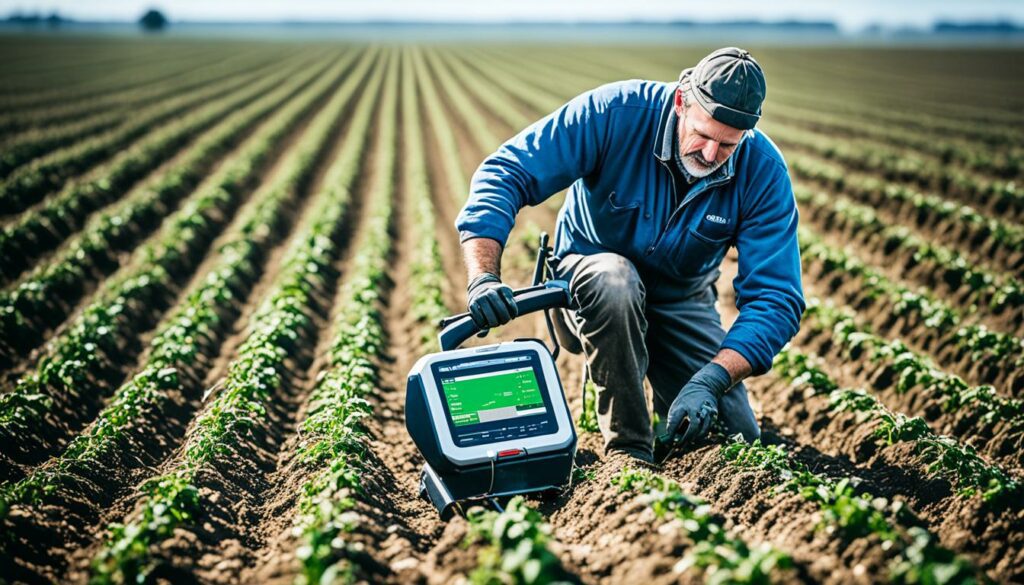
Precision agriculture often needs a lot of money upfront for its specialised tools and tech. This big cost can be a major problem for small farmers. They might not have the money to start. Around 60% of farmers think this tech is too expensive. These costs don’t stop at buying the tools. There are also ongoing costs like software and maintenance.
Farmers need to learn a lot about how to use and gain from precision agriculture. The technology is complex, requiring special training. Many farmers are not very good with digital stuff. This makes it hard for them to understand and use the data. There are also not enough experts who can help set up and use all this technology. Teaching and improving farmers’ skills is key to help them use this tech successfully.
Overcoming these hurdles is important for spreading precision agriculture. Solutions like cheaper tech, better data management, and training can change things. Collaborating with experts and schools can make these solutions more effective. This will help farmers use advanced tech in a good way, making their farms more efficient and sustainable.
Government and industry working together is key to boost the use of precision farming. They offer financial help and push for new research. This support makes a big difference in the farming world.
Getting money to start using precision farming tools is vital for farmers. These tools can be very expensive at the beginning. Luckily, special agriculture funds help cut these costs. The USDA and other groups give loans and subsidies to farmers. This support makes it easier to start using advanced farming methods.
Currently, only 27 percent of U.S. farmers are using precision farming practices. But, with the right funding, this number could go up. More farmers using modern methods can lead to both economic and environmental gains.
Technology in farming keeps growing because of ongoing research. From 2017 to 2021, about $200 million went into making farming tools better. The USDA and the NSF provided this money for precision agriculture R&D.
This research creates new tools and makes the old ones work better. It helps to lower costs and produce more food. This is good news for farmers.
There’s also work being done to sort out who owns the farming data. Making rules for sharing data can remove some big problems. Both financial help and new ideas from the government keep farming moving in the right direction.
In today’s world, precision agriculture is at the forefront of farming. It combines high-tech tools with extensive data analysis. This mix has completely changed how farmers work to increase productivity while caring for the environment. Back in the 1990s, it started with simple soil mapping using handheld gadgets. Now, thanks to companies like John Deere and Agmatix, we get to see its full power. They use data analysis, the Internet of Things (IoT), and machine learning for smart decision making and eco-friendly farm management.
Smart agriculture brought us a range of new tools, from soil and crop sensors to geographic information systems and remote sensors. These innovations offer real-time updates on crop health. Alongside automated machines and robots, they cut down on mistakes and make the best use of resources. This marks the start of a new era for precision agriculture. Now, every aspect of farming is watched, analysed, and made better to boost profits and protect the planet.
The future of precision agriculture looks bright. It aims to tackle global issues like feeding more people and lessening farming’s harm to the environment. It’s vital for governments and businesses to push for the use of these new technologies. Working together, they can make a farming future that’s both sustainable and highly productive for everyone.
Precision agriculture tools help farms work better. They use tech to use resources well and grow crops better. This helps farmers understand what their fields need, reducing waste.
Precision agriculture combines modern tech like GPS and field mapping with farming. It makes every part of the field can get what it needs. This improves how crops grow, leading to better quality and more food.
Tools like GPS, drones, and satellite data are key. They give farmers up-to-date info on their crops. This info includes weather and the environment, allowing for smart decisions.
Precision agriculture is good for the environment and makes farms more efficient. Farms use resources better, waste less, and keep their soil healthy. This all helps the world around us too.
It saves money by cutting down on extra costs and using resources smarter. Less pesticide helps the environment, saving natural resources. This makes farm life better for everyone.
Precision tools make crops reach their full potential. They adjust conditions to be perfect for growth. This way, crops fight off bad weather and grow as much as possible.
By using just what’s needed for water, fertiliser, and pesticides, it saves money and helps the environment. Data guides farmers to use only as much as they need. This way, we make the most out of what we have.
It helps farmers deal with changing weather by giving them immediate advice. They can react quickly to keep their crops healthy, no matter the weather outside.
GPS maps out where to put water, test soil, and sow seeds. It’s great for keeping track of things and making sure every job is done right, even when you can’t see well.
GPS shows farmers exactly where everything is, making work smoother. It also cuts down on waste, making farming better for the wallet and planet.
GIS gives detailed info on what the ground is like and what the plants need. This helps farmers make smart choices and look after their farm better.
GIS makes maps that help farmers understand different parts of their fields. It shows where things need fixing, like getting rid of pests or improving soil. This makes farming smarter and more effective.
GIS uses info from the air and on the ground to watch over plants and soil. It finds problems early so farmers can act in time and keep their crops healthy.
UAVs, or drones, take detailed pictures of the fields from above. This helps farmers see how their crops are doing without walking the whole field. It checks plant health and spots problems early.
UAVs use special cameras to see what’s really happening with the crops. This aerial view lays out crop health and soil info, highlighting what needs attention. It’s a fast way to keep the farm running smoothly.
Drones make checking on the fields easier, more accurate, and less work. This means better choices and a more productive farm. It’s like the eyes in the sky for the farm.
Satellites quickly share detailed info about the crops. This near instant info on moisture and disease helps farmers act fast to keep the crops healthy. It’s like having a planet’s worth of scouts for the farm.
Detail-rich images help farmers see exactly what their fields need. This targeted view means they can use the right solutions in just the right spots, making the farm more efficient.
Real-time data from the sky lets farmers watch over their crops all the time. This timely advice on conditions and problems means they can react quickly to keep everything growing well.
By working together, software and hardware like EOSDA Crop Monitoring make managing a farm easier. They pull in info from different sources, helping farmers make the best choices.
Farm platforms help farmers make decisions faster, run things smoother, and use resources better. This smart management saves money and helps the farm last for the long term.
VRT custom-tailors the use of fertilisers, chemicals, and seeds for each spot in a field. This approach cuts waste and does a better job at taking care of the plants, saving both money and resources.
By using less unnecessary stuff, VRT saves money and is kinder to the planet. Farms need less of the stuff that’s not good for the environment, helping keep things cleaner and healthier.
Watching and mapping how much the fields produce is key to making the right choices. This data helps farmers plan better, making their fields more productive. It’s all about using what they know to do better next time.
Field data is collected using GPS and satellites. Then, special tools turn this data into maps and insights. These insights help farmers manage their fields better.
New tools include sensors in the ground and robots that tame weeds. They cut down on hard work and make farms more efficient and less wasteful. It’s about farming smarter for a better future.
These sensors give data on the spot about the soil and plants. This real-time info helps farmers fine-tune their care, leading to healthier crops and less guesswork.
Automatic machines take over planting and weeding. They do the job well and free up time, making farms more productive and efficient. It’s like having extra hands that don’t need breaks.
Getting started can be expensive and needs special training. Plus, some farmers need to learn more about the tech and how to manage all the data. It’s a learning curve for a better farm future.
Government groups like USDA and NSF help with funds and advice on tech for farming smarter. They offer loans and grants to make the initial cost easier to handle.
There’s ongoing work to make better AI, tools, and tech for farming. This research aims to keep farms growing more food and doing it in a way that’s good for the land for years to come.